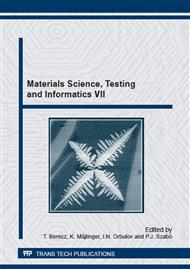p.339
p.345
p.351
p.357
p.363
p.369
p.375
p.381
p.387
Determination of the Guidewire’s Visibility
Abstract:
The purpose of our research was the development of a new algorithm to the objective quantification of guidewire’s visibility; which is suitable for the classification and comparison of different guidewires, according to this property. The guidewire is a flexible medical device, over which the catheter or the dilator is lead into the vascular system to assist the insertion and position of these devices. During the insertion and the removal of guidewire the movement of distal end is monitored under fluoroscopy. At the beginning of our experiments two algorithms were developed and applied: the first one investigated the total distal end, while the second one investigated two parts of the distal end. Both algorithms were tested on ten guidewires made of same brand and material, so their relative visibility (the visibility of guidewire’s investigated part compared the background) were determined by both method. The average relative visibility was 19.8%±3.0% in case of algorithm for total distal end, and it was 21.5%±2.9% in case of algorithm for two part of distal end. The coefficient of variation was calculated in case of both algorithms, thus characterized by their reliability. Both coefficient of variation were low (0.15 and 0.13), so the algorithms were considered to be reliable. The two algorithm were no significant different (p=0.15), therefore the investigation of the total distal end might be replaced by the investigation of two parts.
Info:
Periodical:
Pages:
363-367
Citation:
Online since:
February 2015
Authors:
Keywords:
Price:
Сopyright:
© 2015 Trans Tech Publications Ltd. All Rights Reserved
Share:
Citation:


